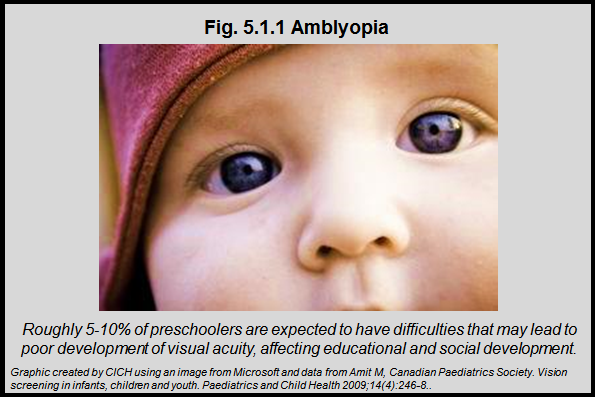Amblyopia

…continued
American guidelines recommend that all children between the ages of 3 and 5 years have vision screening to detect the presence of amblyopia or its risk factors.4 The Canadian Task Force on Preventive Health Care has no recommendations3, however the Canadian Paediatric Society recommends visual examination during routine infant and well-child visits starting from birth. They also recommend that children with known risk factors, and those with abnormalities or reading difficulties be examined by trained eye professionals.1,5
1National Eye Institute. https://www.nei.nih.gov/health/amblyopia
2Amit M, Canadian Paediatrics Society. Vision screening in infants, children and youth. Paediatrics and Child Health 2009;14(4):246-8.
3Canadian Task Force on Preventive Health Care. New grades for recommendations from the Canadian Task Force on Preventive Health Care. CMAJ 2003; 169:207-8.
4Chou R., Dana T., Bougatsos, C. Screening for Visual Impairment in Children Ages 1 – 5 Years: Systematic Review to Update the 2004 U.S. Preventive Services Task Force Recommendation. Evidence Synthesis No. 81. AHRQ Publication No. 11-05151-EF-1. Rockville, MD: Agency for Healthcare Research and Quality; February 2011.
5Mema SC, McIntyre L, Musto R. Childhood vision screening in Canada: Public health evidence and practice. Canadian Journal of Public Health 2012;103(1):40-5.
Amblyopia is the medical term used when the vision in one eye is reduced because the eye and the brain are not working together properly. This condition is also known as lazy eye.1 It is one of the most common causes of monocular (one eye) blindness among adults between the ages of 20 and 70 years.2,3 Amblyopia tends to develop before age 6 and does not improve with the use of prescription lenses. Approximately 5-10% of preschoolers are expected to have difficulties that may lead to poor development of visual acuity, affecting educational and social development.2 continued…
